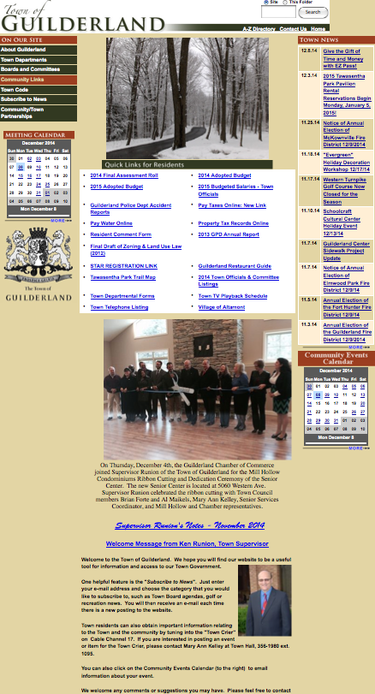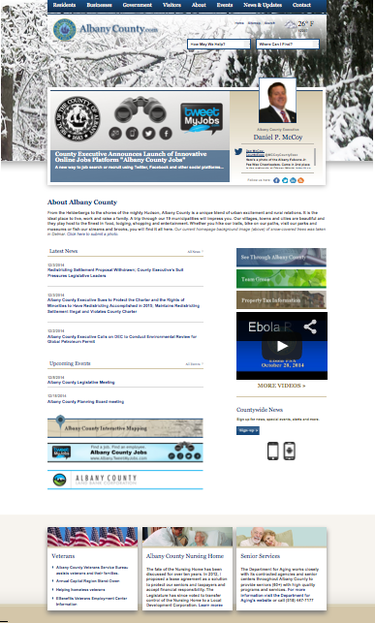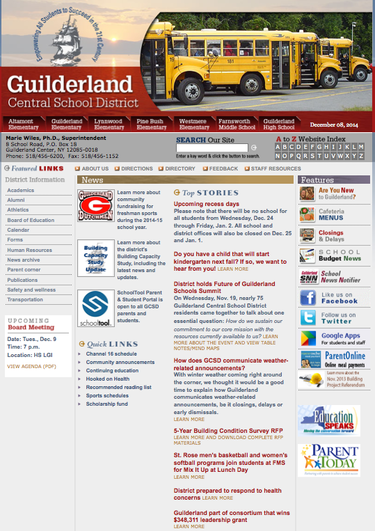Empire Center finds most websites for public are failures
ALBANY COUNTY — This fall, the Empire Center for Public Policy released its first evaluation of websites for the state’s 500 largest counties, municipalities, and school districts — and gave 85 percent of them failing grades. In the Enterprise coverage area, three were evaluated: The county of Albany and the town of Guilderland both got Fs while the Guilderland Central School District earned a C.
Reactions were mixed.
“I think the report was a valid lens,” said Amy McGeady, the public information officer for the school district, who re-designed the district’s website in 2010 and maintains it daily. “It gave me ideas for improvement.”
She added, “It’s one of many lenses.... We’re always looking to improve. Any feedback is good.”
“They were criticizing us, and the emails they sent us were unreadable,” said Kenneth Runion, supervisor for the town of Guilderland, which has had a website since 2001.
He also said, “Usually, if less than 50 percent get a passing grade, something is wrong with the criteria.”
“We’ve made great strides with our website and improved by leaps and bounds,” said Mary Rozak, spokeswoman for the Albany County Executive’s Office, referring to the site launched by the county in August 2013.
She also said, “We have active Twitter and Facebook pages; it’s the way people these days interact. We get a lot of responses for county initiatives” through social media, she said. “Everything is intertwined,” Rozak said, noting a website is just part of digital communication with the public. “It’s cyclical, a symbiotic relationship,” she said.
The Empire Center reviewed the websites between July and September of this year, and Tim Hoefor, the author of the report, concluded, that most “need major improvements before they will be providing citizens with all the public information to which they are entitled.”
The study appraised websites in 10 categories, assigning points for each and then converting those points to a letter grade. Grading was not comparative or done on a curve; 427 out of 500 websites got Fs. Ninety-two percent of the school districts that were evaluated failed as did 79 percent of the towns and 72 percent of the counties.
The majority of local governments passed in only four categories: Public meetings (79 percent), taxes and fees (64 percent), facilities and services (63 percent), and budgets (63 percent). The posting of public meetings, the report notes, is required by state law, which dozens of localities violate.
The lowest passage rate, at 1 percent, was for posting contracts. This is important, the report states, because employee compensation makes up the largest category of all local government and school expenditures, and the report asserts that “a proper vetting of contracts by the public can even prevent costly mistakes.”
The most common shortcoming, the report said, was a lack of financial information, including taxes and fees, expenditures, and budgets.
The report also includes a handful of websites with high ratings, to be used as models — Schuyler County, New York City, the town of Wilton, and the Clarkstown Central School District. They all earned Bs; no municipality or school district earned an A.
Some municipalities, such as Ballston Spa, received a score of zero since they had no website during the review period.
Initial scores and grades from the study were shared with heads of municipalities or school districts through email addresses posted on their websites. The officials were given seven days to respond with comments or objections and a “small number of revisions were made” based on comments, the report says.
“The Empire Center undertook this project not to place blame on any individual local government, rather to highlight the need for advancement in how and when data and information is presented on websites,” the report states.
The Empire Center, an Albany think tank, is a non-partisan, independent not-for-profit.
Its report also says most, if not all, of the changes to be made based on the assessment “can be achieved at little or no cost” to better connect taxpayers “to the range of information to which they are entitled.”
Town of Guilderland
The town received a total of 68 points out of a possible 146; points less than 95 resulted in an F.
“Our original site was built from scratch,” said Runion. “It was tough to use and update.” The current site, he said, is based on a template provided by a vendor. It is maintained by the town’s public information officer, Linda Cure.
Runion said he had received an email from the Empire Center. “I couldn’t read it,” he said. “It was something with the way they sized it. I couldn’t figure out what they were trying to tell me. I just got frustrated and deleted it.”
Guilderland got 8 out of a possible 10 points for contact information. The report’s rubric awards one point each for name, phone, email, biography, and photo of all elected officials, department heads, and senior administrators and up to 4 points for ease of navigation.
“They may have been looking for email for every board member,” surmised Runion. “Some don’t want it listed,” he said, calling it a “privacy issue.”
Since town board members are part-time, Runion said, they wouldn’t have a town hall mailbox.
The town earned 15 out of 16 points for public-meeting information, which includes points for posting meeting notices and minutes with bonus points for streaming public meetings.
“That should be the main function” of a municipal website, said Runion. “That’s what we set up our website for.”
On public information, the town got 0 out of a possible 12 points.
“I have no idea what they’re looking for,” said Runion. “They may be looking for links,” he said, noting the village of Altamont’s site is the only one that the town links to. “Businesses want to link and we don’t allow it,” said Runion, “because we don’t know where they go.”
The rubric for public information allows 3 points for a direct link to the Freedom of Information Law web page and up to 4 points for ease of finding information. Then, it awards 1 point each for name and contact information for the records access officer; for the address, phone number and email address for submitting FOIL requests; for the name and contact information of an appeals officer; for disclosing the FOIL fee policy; and for disclosing the FOIL response time.
Runion said that most of Guilderland’s FOIL requests come from reporters.
The town earned 15 out of a possible 16 points for budgets.
“We post all of our budget information,” said Runion. “This year, we posted all our worksheets.... It gets to be lengthy so we have summaries for a quick answer. That’s what residents are looking for.”
Guilderland got 0 out of 16 points for financial reports. The rubric allows 5 points for posting the most recent audited comprehensive financial report, up to 3 points for past reports, up to 4 points for posting audits, and up to 4 points for ease of finding information.
“There’s only one financial report and that goes to the state comptroller,” said Runion. He suggested people could look for that report on the comptroller’s site.
“It’s confusing to read, too,” he said, adding, “We could put it on our website, too; it’s not a big deal.”
The town received 0 out of 22 points for contracts.
“We never have,” said Runion of posting contracts. “There’s too many to post...We could,” he went on. “I don’t think it’s a big issue. We’ve never had anyone ask for them.”
The town got 6 out of 16 points on taxes and fees. The rubric allows up to 4 points each for disclosing tax rates, all fees, all revenue sources, and for ease of finding the information.
“I think we post all of those,” said Runion. “Maybe they didn’t locate them.”
The town received 8 out of a possible 12 points on expenditures. The rubric awards up to 4 points each for payroll data, expenditure data, and ease of finding the data.
Guilderland earned all 12 of the possible 12 points for facilities and services.
“Every facility has a link,” said Runion, “and each department has an area with information and descriptions of services, with contact information.”
The town got 4 out of a possible 10 points for ease of navigation.
“That’s more of a software issue,” said Runion.
“The things we scored well on is the information we find most people are looking for,” concluded Runion, naming notices of public meetings, budgets, and services and facilities.
“I’m always happy to look at stuff,” he said. “There’s always room for improvement...like putting collective bargaining agreements online; that’s fairly simple.”
Albany County
Albany County scored 13 points higher than Guilderland — with 81 out of 146 points — but was still 10 points away from the 91 points it would take to get a passing grade of D.
Referring to Daniel McCoy, Rozak said, “The county executive wanted to make things transparent” and to make the website “user-friendly" since, she said, the original county website was “difficult to navigate.”
“Ours is patterned after different websites we liked,” she said, pointing out the county site’s “streamlined” look, with a central portion devoted to listing news and events; colored bars on the right rail for tax information, See Through Albany County, and Team Green; and then boxes at the bottom linking to programs like senior services.
Referring to “different naming conventions,” Rozak said the new site added more search possibilities.
After requests for proposals were sent out, the county hired a local company, L&P Media, to design the site.
Each county department has a “website liaison,” said Rozak, so, as material becomes available, it is passed to the chief information officer, Christine Quinn, who acts as a “gatekeeper,” making sure it is reviewed and in the right format.
After the new site was launched, “almost immediately,” Rozak said, the county got fewer calls since the old site had been so much harder to navigate.
The county did best in the budgets category, getting 15 out of a possible 16 points.
In addition to posting budget documents, Rozak said, the site offers surveys so “the public can tell us what is important to them.” The survey was introduced as part of the re-launch and the response was “not as much as we would like,” said Rozak. It will be used again this year.
On contact information, the county got 8 out of 14 points.
“This is an evolving process,” said Rozak. “We know there are things we need to do,” said Rozak.
She said the contact information “is not only accurate but thorough.”
On public meetings, the county got 7 out of a possible 16 points.
Some things the executive’s office has “no control over,” said Rozak. “We have no jurisdiction over what the legislature is doing,” she said.
She added, “We post public hearings in a timely fashion.”
On public information, the county earned 9 out of 12 points.
“We put up every single press release and every single statement,” said Rozak, making it easy for the public to find. She gave the example that, during flu season, not only are clinics posted but there is also a taped video message from the health commissioner.
Another example she gave was of how information, for instance, for veterans, is grouped so that veterans can obtain information ranging from filling out forms to getting discounts at merchants throughout the county.
The county got 9 out of 16 points on financial reports, and 6 out of 12 points on expenditures.
Very shortly, Rozak said, the county will be posting “real-time financial reports,” with year-to-date information on, for example, expenditures and overtime pay.
She added, “It’s taking so much time to get all the kinks out. We’ve been working on it for the better part of this year.”
On contracts, the county got 7 out of 22 points. The county’s legal and tech teams will have to be consulted, she said, on what contracts can be posted.
The county got 9 out of 16 points on taxes and fees.
Rozak noted tax forms are posted on the site and said she’d be interested to find out what else people are interested in.
On facilities and services, the county got 7 out of 12 points.
“What’s posted is leaps and bounds ahead of a year ago,” said Rozak. “Could we post more? Possibly.”
On ease of navigation, the county got 4 out of 10 points.
“I would disagree with that,” said Rozak. She went on to describe many features that make the site easy to navigate, including the simple way the drop-downs work, the “How may we help?” feature at the top of the web page, the tabs at the top, and the cross-reference to videos.
“A variety of places can get you to the same information because people search for things differently,” she said. “We all think differently.”
She concluded of having a website, “It’s a two-way street. We always welcome feedback.”
Guilderland schools
The Guilderland Central School district earned 98 out of a possible 141 points for schools. A C is 98 to 112 points; less than 91 points is an F. Schools were not judged on the “facilities and services” category that municipalities were, but shared the other nine categories.
Of all the schools studied, one district earned a B, four had Cs, eight had Ds, and all the rest had Fs — placing Guilderland, with its C, in the top five statewide.
When McGeady heard from her colleagues at the Board Of Cooperative Educational Services about emails they had received on the Empire Center’s website report cards, she tracked down the one that had been sent to Guilderland but was languishing in the superintendent’s spam folder.
“I found ours and didn’t agree with some of the assessments,” she said. She called the author of the report and had what she described as a “pleasant” 20-minute conversation, pointing out some of the site’s attributes that were overlooked.
“Our scores got adjusted,” she said.
McGeady designed the site through the Capital Region BOCES with templates. She posts 90 percent of the information herself. “I’m on there several times every single day,” she said. The work is covered as part of her salary.
Others help; for example, the librarians maintain the library pages, and the music supervisor maintains the music page.
One of the things McGeady is most proud of in the design of the school district’s website is “the navigation rails that make it easy for students and staff to find information.”
She also pointed out the “A to Z” feature that lets visitors to the site find information through an alphabetical listing if they can’t find it elsewhere.
On contact information, the district got 18 points out of a possible 25, which McGeady called “a fair grade.”
“There’s no comprehensive district-wide directory,” said McGeady. “We may look into that in the future.”
Currently, staff is listed under each of the district’s seven schools.
McGeady noted that the school board’s communication committee is looking at improving the information on board members, which currently includes photographs for all nine board members and contact information for eight of them but no biographical information.
On public meetings, the district got the full number of points available, 16.
“We post all the meetings and agendas and all the program reports,” said McGeady.
The district got 3 out of 12 points on pubic information.
McGeady noted that the site has information for FOIL requests and responses, and the name and contact information for the records officer but that it may not be immediately obvious.
On budgets, the district got 13 out of 16 points.
McGeady described the budget information as “robust,” noting the district keeps a running archive of budget information from 2008-09 on.
“You can look at vote tallies for the board and for the public,” she said.
Additionally, budget drafts are posted as well as “Q and A” documents to answer citizen questions.
The district received 10 out of 16 points for financial reports.
“This refers to our audit information,” said McGeady. “We had points deducted for the ease of finding it.”
She noted that the audit information is in the board of education pages for program reports and said that, in the future, she’d do “a better job of pointing to where that is.”
On contracts, Guilderland got 12 out of 22 points.
“We have all of our bargaining unit contracts posted for several years,” said McGeady, noting they are on the human resources pages.
The district got 11 out of 12 points for taxes, which McGeady again called “fair.”
On expenditures, the district got 8 out of 12 points.
McGeady said 4 points were deducted for not disclosing employee payroll data.
“That tool already exists for New Yorkers,” she said, citing the web portal run by the Empire Center, SeeThroughNY, which lists public employees salaries.
“Why would we re-create the wheel?” she asked.
On ease of navigation, the district got 7 out of 10 points.
“Ironically, that’s an area I’m proud of,” said McGeady.
She went on, “Part of it is the subjective nature of reviews.... We have so many different audiences. Parents want the lunch menu on the homepage,” she said, giving one example that may displace an audit from the homepage. “With a site as big as ours, not everything can fit on the homepage,” said McGeady.
McGeady said she was unaware of any other outside agency evaluating public websites but, at Guilderland, there’s “an ongoing internal evaluation,” she said.
She described “a light-bulb moment” when someone requests something on the website and she concludes, “If you’re looking for it, someone else is, too.”
The Capital Region BOCES Communications Team, of which she is a member, is “constantly reviewing best practices,” said McGeady.
With the rise of social media, and Guilderland’s use of the School News Notifier directly updating subscribers of school news, there is still an important place for the website, she said. “It has archive value,” concluded McGeady.





